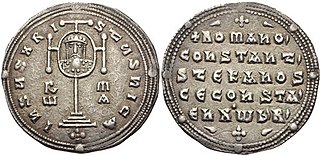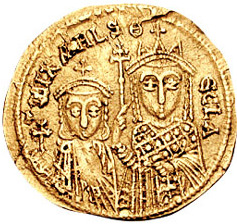 W
WAlexander, sometimes numbered Alexander II, or Alexander III ruled as Emperor of the Byzantine Empire in 912–913.
 W
WArethas of Caesarea was Archbishop of Caesarea Mazaca in Cappadocia early in the 10th century, and is considered one of the most scholarly theologians of the Greek Orthodox Church. The codices produced by him, containing his commentaries are credited with preserving many ancient texts, including those of Plato and Marcus Aurelius' "Meditations".
 W
WBasiliskianos, also Basiliskos (Βασιλίσκος) or Basilikinos (Βασιλικῖνος), was a Byzantine courtier and companion of emperor Michael III.
 W
WConstantine was a prince of the Byzantine Empire and co-emperor.
 W
WCyril and Methodius (815–885) were two brothers and Byzantine Christian theologians and missionaries. For their work evangelizing the Slavs, they are known as the "Apostles to the Slavs".
 W
WDanielis was a widowed Byzantine noblewoman from Patras. According to the written tradition she was an extremely wealthy landowner, owning a significant part of the Peloponnese, as well as a flourishing carpet and textile industry. However, Ilias Anagnostakis has argued that the narrative about Danielis is not merely exaggerated but largely fictional. Her relationship with Basil I was modeled on that between King Solomon and the queen of Sheba on the one hand and Alexander the Great’s visit to Kandake on the other. The invention was meant, along with the other miraculous tales told about Basil in that text, to base his legitimacy and heroic stature in the realm of romantic fable and Scriptural parallel.
 W
WEuthymius of Sardis was metropolitan bishop of Sardis between ca. 785 and ca. 804, and a leading iconophile during the period of Byzantine Iconoclasm. Martyred in 831, he is a saint in the Eastern Orthodox Church, celebrated on 26 December.
 W
WEudokia (Eudocia) Ingerina was a Byzantine Empress as the wife of the Byzantine emperor Basil I, the mistress of his predecessor Michael III, and the mother of Leo VI the Wise, Alexander and Stephen I of Constantinople.
 W
WSaint Joseph the Hymnographer was a Greek monk of the ninth century. He is one of the greatest liturgical poets and hymnographers of the Eastern Orthodox Church, but as a poet he is often confused with Joseph, the Archbishop of Thessalonica and brother of Theodore the Studite, who were one generation older than he was. He is also known for his confession of the Orthodox Faith in opposition to Iconoclasm. He is called in certain sources "the sweet-voiced nightingale of the Church".
 W
WKassia, Cassia or Kassiani was a Byzantine abbess, poet, composer, and hymnographer. She is one of the first medieval composers whose scores are both extant and able to be interpreted by modern scholars and musicians. Approximately fifty of her hymns are extant and twenty-three are included in Orthodox Church liturgical books. The exact number is difficult to assess, as many hymns are ascribed to different authors in different manuscripts and are often identified as anonymous.
 W
WThe Martyrs of Adrianople were three hundred and seventy seven Christians who were executed in 815. They are commemorated by the Eastern Orthodox Church on 22 January.
 W
WNarjis bint Yashoua was the wife of Imam Hasan al-Askari and the mother of the final Imam of Twelver Shia Islam. Her name has been recorded as Narjis, Saiyra, Katrina, Lilliana, Malika, and primarily Anna, in books. More sources have described her as a "Roman princess" who pretended to be a slave so that she might travel from her kingdom to Arabia. Mohammad Ali Amir-Moezzi, in the Encyclopædia Iranica, suggests that the last version is "undoubtedly legendary and hagiographic". According to Ibn Babawayh's account, Narjis saw Mary, the mother of Jesus, and Fatimah, the daughter of Muhammad, in her dreams wherein they asked for her hand in marriage to Hasan al-Askari.
 W
WPeter the Athonite is reputed to have been the first hermit to settle upon the Mount Athos. Peter is known to history primarily through unattributable legend. It is recorded that Peter was once a soldier who, through the miraculous aid of St. Nicholas and St. Simeon the Righteous, was freed from a Muslim military prison. From prison St. Peter traveled to New Rome to fulfill a promise to God that he would take the monastic habit. It is held that Peter received his habit from the Pope himself who also formed the saint in monastic discipline. Receiving a vision of the Blessed Virgin and Theotokos Mary, Peter traveled to Mt. Athos and there lived for some fifty years.
 W
WRomanos I Lekapenos, Latinized as Romanus I Lecapenus, was an Armenian who became a Byzantine naval commander and reigned as Byzantine Emperor from 920 until his deposition on December 16, 944.
 W
WSaint Symeon Stylites of Lesbos (765/66–844) was a monk who survived two attempts on his life during the second period of Byzantine Iconoclasm (814–842). He followed a similar model to Simeon Stylites, residing on a pillar-like structure similar to a tower. There he isolated himself from the world and fasted, prayed and studied. He is venerated with his two brothers, Saint George the Archbishop of Mytilene and Saint David the Monk.
 W
WThekla was a princess of the Amorian dynasty of the Byzantine Empire.
 W
WTheodora was a Byzantine empress as the spouse of the Byzantine emperor Theophilos, and regent of her son, Michael III, from Theophilos' death in 842 to 855. For her restoration of the veneration of icons, which ended the Byzantine Iconoclasm, she is venerated as a saint in the Eastern Orthodox Church; her Feast Day is 11 February. Several churches hold her as their patron saint.
 W
WTheoktiste, also known as Phlorina (Φλώρινα), was the mother of the 9th-century Byzantine empress Theodora, the wife of Emperor Theophilos.
 W
WTheoktistos was a leading Byzantine official during the second quarter of the 9th century and the de facto head of the regency for the underage Michael III from 842 until his dismissal and murder in 855. A eunuch, he assisted in the ascent of Michael II to the throne in 822, and was rewarded with the titles of patrikios and later magistros. He held the high posts of chartoularios tou kanikleiou and logothetēs tou dromou under Michael and his son Theophilos. After Theophilos' death in 842, Theoktistos became member of the regency council, but soon managed to sideline the other members and establish himself as the virtual ruler of the Empire. Noted for his administrative and political competence, Theoktistos played a major role in ending the Byzantine Iconoclasm, and fostered the ongoing renaissance in education within the Empire. He also continued the persecution of the Paulicians, but had mixed success in the wars against the Arabs. When Michael III came of age in 855, his uncle Bardas persuaded him to throw off the tutelage of Theoktistos and his mother, the Empress Theodora, and on 20 November 855, Theoktistos was assassinated by Bardas and his followers.
 W
WTheophano Martinakia was a Byzantine Empress by marriage to Leo VI the Wise. She is venerated as a saint by the Eastern Orthodox Church.
 W
WThomas the Slav was a 9th-century Byzantine military commander, most notable for leading a wide-scale revolt in 821–23 against Emperor Michael II the Amorian.